Trade War's Impact on Australia: KPMG Report Analysis, 2019
VerifiedAdded on 2022/10/15
|7
|1829
|35
Report
AI Summary
This report examines the impact of trade wars, particularly the US-China trade conflict, on Australia's economy, drawing on the KPMG Australia report published in 2018. The analysis explores various scenarios, including limited escalation, full escalation with no contagion, and full escalation with contagion, assessing their effects on Australia's GDP, household income, and employment. The report highlights the detrimental effects of trade wars on Australia's largest exports, such as resources and education, and the negative consequences for farmers, miners, and the overall supply chain. It discusses the implications of tariffs imposed by both the US and China and analyzes the responses and retaliatory measures taken by both countries. The report also examines the impact of the trade war on Australia's trading partners and the potential for global economic decline. It concludes that there are no winners in this trade war, and that it is important to avoid political pressure to participate in escalating trade wars. The report also references the temporary trade truce formed at the G20 summit and the subsequent escalation of tariffs and trade restrictions. The document emphasizes the importance of international trade for economic prosperity and the negative impacts of protectionism on globalization, innovation, and cultural diversity.
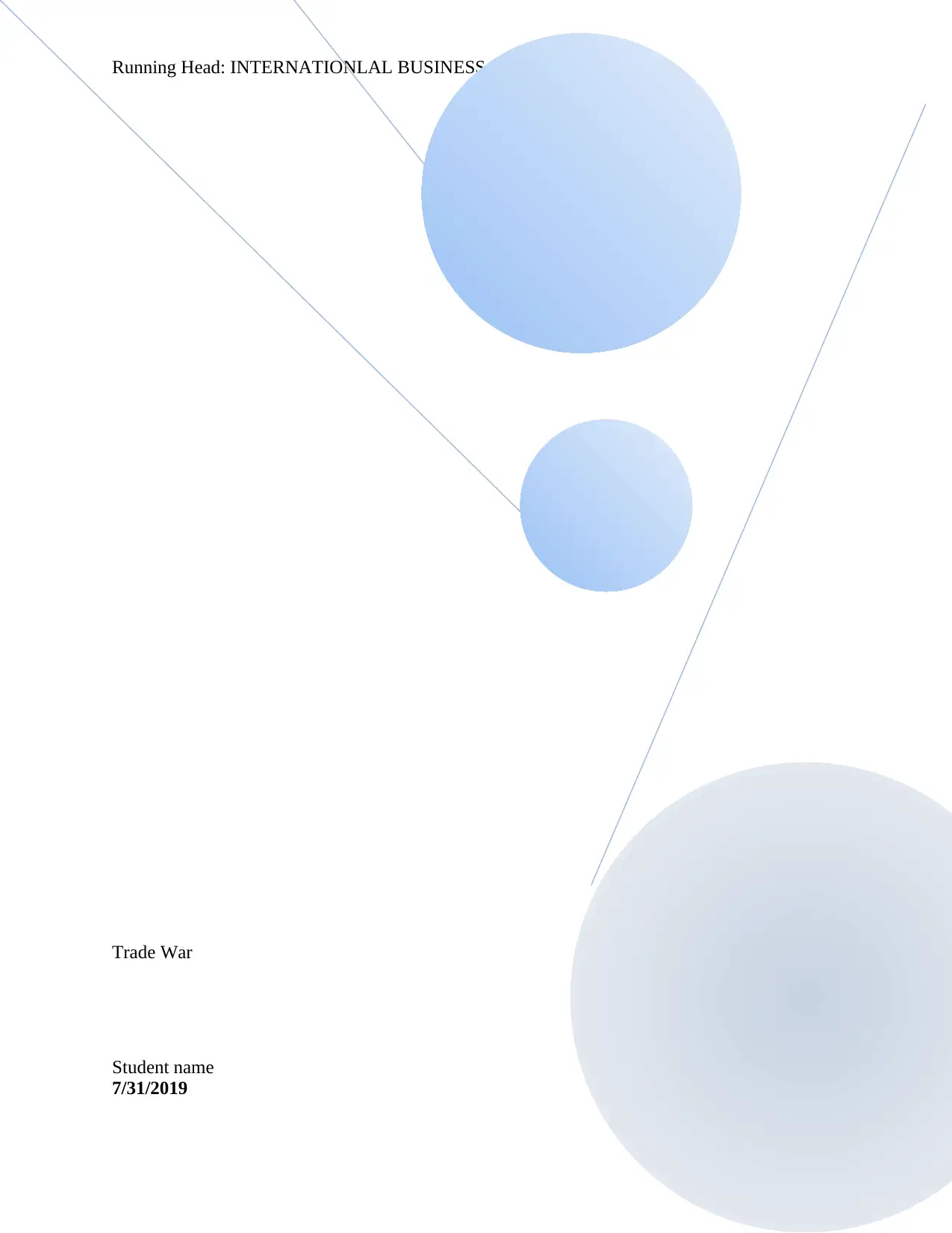
Running Head: INTERNATIONLAL BUSINESS
0
Trade War
Student name
7/31/2019
0
Trade War
Student name
7/31/2019
Paraphrase This Document
Need a fresh take? Get an instant paraphrase of this document with our AI Paraphraser
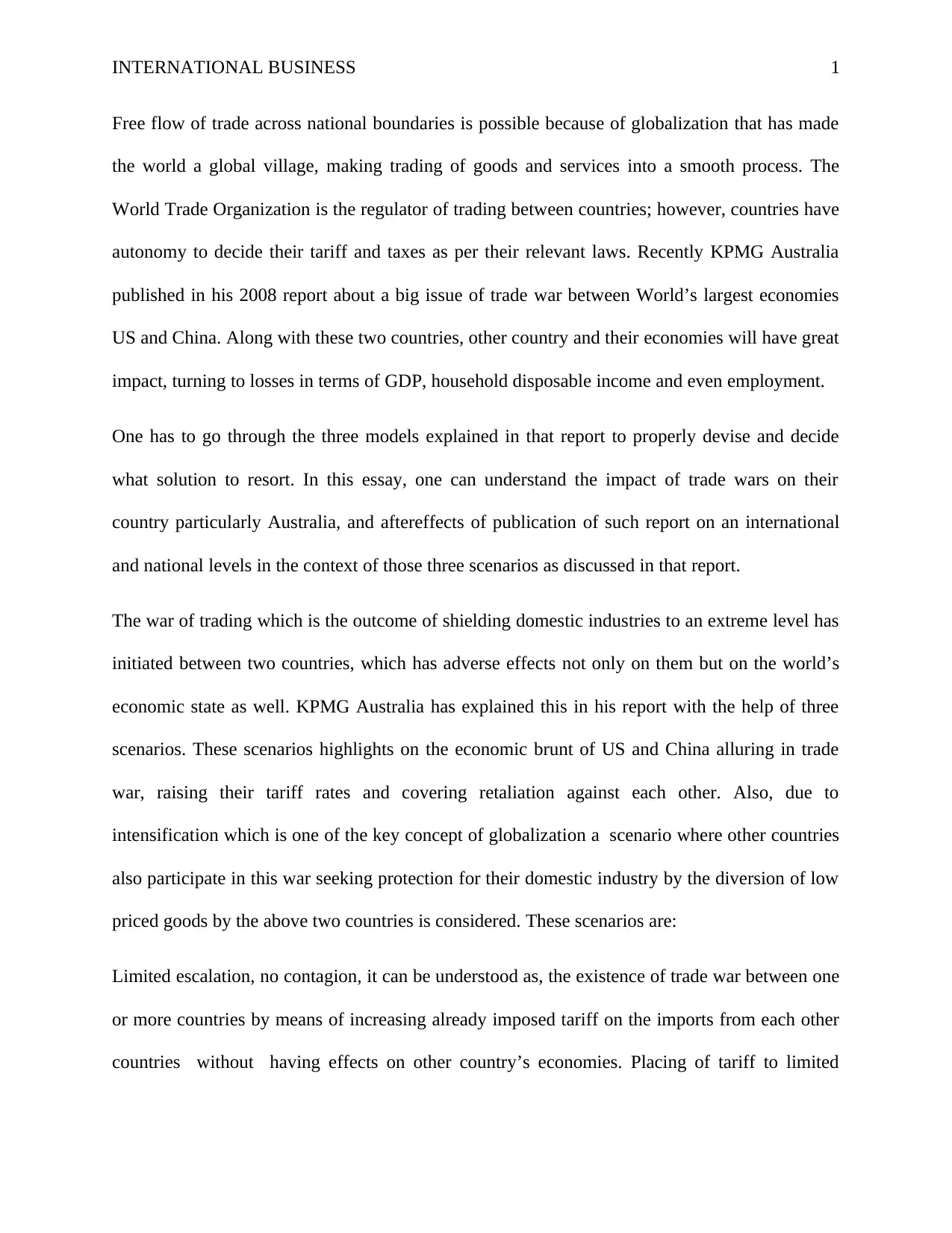
INTERNATIONAL BUSINESS 1
Free flow of trade across national boundaries is possible because of globalization that has made
the world a global village, making trading of goods and services into a smooth process. The
World Trade Organization is the regulator of trading between countries; however, countries have
autonomy to decide their tariff and taxes as per their relevant laws. Recently KPMG Australia
published in his 2008 report about a big issue of trade war between World’s largest economies
US and China. Along with these two countries, other country and their economies will have great
impact, turning to losses in terms of GDP, household disposable income and even employment.
One has to go through the three models explained in that report to properly devise and decide
what solution to resort. In this essay, one can understand the impact of trade wars on their
country particularly Australia, and aftereffects of publication of such report on an international
and national levels in the context of those three scenarios as discussed in that report.
The war of trading which is the outcome of shielding domestic industries to an extreme level has
initiated between two countries, which has adverse effects not only on them but on the world’s
economic state as well. KPMG Australia has explained this in his report with the help of three
scenarios. These scenarios highlights on the economic brunt of US and China alluring in trade
war, raising their tariff rates and covering retaliation against each other. Also, due to
intensification which is one of the key concept of globalization a scenario where other countries
also participate in this war seeking protection for their domestic industry by the diversion of low
priced goods by the above two countries is considered. These scenarios are:
Limited escalation, no contagion, it can be understood as, the existence of trade war between one
or more countries by means of increasing already imposed tariff on the imports from each other
countries without having effects on other country’s economies. Placing of tariff to limited
Free flow of trade across national boundaries is possible because of globalization that has made
the world a global village, making trading of goods and services into a smooth process. The
World Trade Organization is the regulator of trading between countries; however, countries have
autonomy to decide their tariff and taxes as per their relevant laws. Recently KPMG Australia
published in his 2008 report about a big issue of trade war between World’s largest economies
US and China. Along with these two countries, other country and their economies will have great
impact, turning to losses in terms of GDP, household disposable income and even employment.
One has to go through the three models explained in that report to properly devise and decide
what solution to resort. In this essay, one can understand the impact of trade wars on their
country particularly Australia, and aftereffects of publication of such report on an international
and national levels in the context of those three scenarios as discussed in that report.
The war of trading which is the outcome of shielding domestic industries to an extreme level has
initiated between two countries, which has adverse effects not only on them but on the world’s
economic state as well. KPMG Australia has explained this in his report with the help of three
scenarios. These scenarios highlights on the economic brunt of US and China alluring in trade
war, raising their tariff rates and covering retaliation against each other. Also, due to
intensification which is one of the key concept of globalization a scenario where other countries
also participate in this war seeking protection for their domestic industry by the diversion of low
priced goods by the above two countries is considered. These scenarios are:
Limited escalation, no contagion, it can be understood as, the existence of trade war between one
or more countries by means of increasing already imposed tariff on the imports from each other
countries without having effects on other country’s economies. Placing of tariff to limited

INTERNATIONAL BUSINESS 2
preannounced tradable items will have small effect on both of US and China while having little
effect on other countries.
Full escalation, no contagion, meaning increase in the imposed tariff by further 25% between
two countries and similar to above without giving shock to other countries’ economies. GDP of
China would be reduced by estimate of 1% in 2021. In Case Of US, it will be reduced by 0.4% in
coming four years (Malakellis, Emerson , & Rynne, 2018). Country like Australia has more to
loose and nothing to gain. GDP (real) loss of about 0.5% would take place equation to a$60
billion loss in present value terms. If shielding domestic industries increases economically it
would be painful for everyone.
Full escalation, full contagion, under this, what would be the effect on the economy will be
created if other remaining countries participate in the trade war and impose tariff of 15% on all
manufactured goods or all tradable goods is discussed. This scenario will intensify the effect of
trade war and can extend to world’s greatest recession.
Trade war has created a great impact on Australia’s largest exports of resources and education
sector. Tourist and students who used to visit Australia for study and tourist purpose no more
able to spend money as, buying power of China has become weak, resulting in discouraging
Chinese to visit as tourist and study in Australian University, hence slowing economy creating
unemployment and demand for ore and coal.
The strain of trade war between US and China will affect not only Australian exporters,
manufacturers and ultimate consumers but also adversely hit farmers, miners as a result affecting
the whole supply chain.
preannounced tradable items will have small effect on both of US and China while having little
effect on other countries.
Full escalation, no contagion, meaning increase in the imposed tariff by further 25% between
two countries and similar to above without giving shock to other countries’ economies. GDP of
China would be reduced by estimate of 1% in 2021. In Case Of US, it will be reduced by 0.4% in
coming four years (Malakellis, Emerson , & Rynne, 2018). Country like Australia has more to
loose and nothing to gain. GDP (real) loss of about 0.5% would take place equation to a$60
billion loss in present value terms. If shielding domestic industries increases economically it
would be painful for everyone.
Full escalation, full contagion, under this, what would be the effect on the economy will be
created if other remaining countries participate in the trade war and impose tariff of 15% on all
manufactured goods or all tradable goods is discussed. This scenario will intensify the effect of
trade war and can extend to world’s greatest recession.
Trade war has created a great impact on Australia’s largest exports of resources and education
sector. Tourist and students who used to visit Australia for study and tourist purpose no more
able to spend money as, buying power of China has become weak, resulting in discouraging
Chinese to visit as tourist and study in Australian University, hence slowing economy creating
unemployment and demand for ore and coal.
The strain of trade war between US and China will affect not only Australian exporters,
manufacturers and ultimate consumers but also adversely hit farmers, miners as a result affecting
the whole supply chain.
⊘ This is a preview!⊘
Do you want full access?
Subscribe today to unlock all pages.

Trusted by 1+ million students worldwide
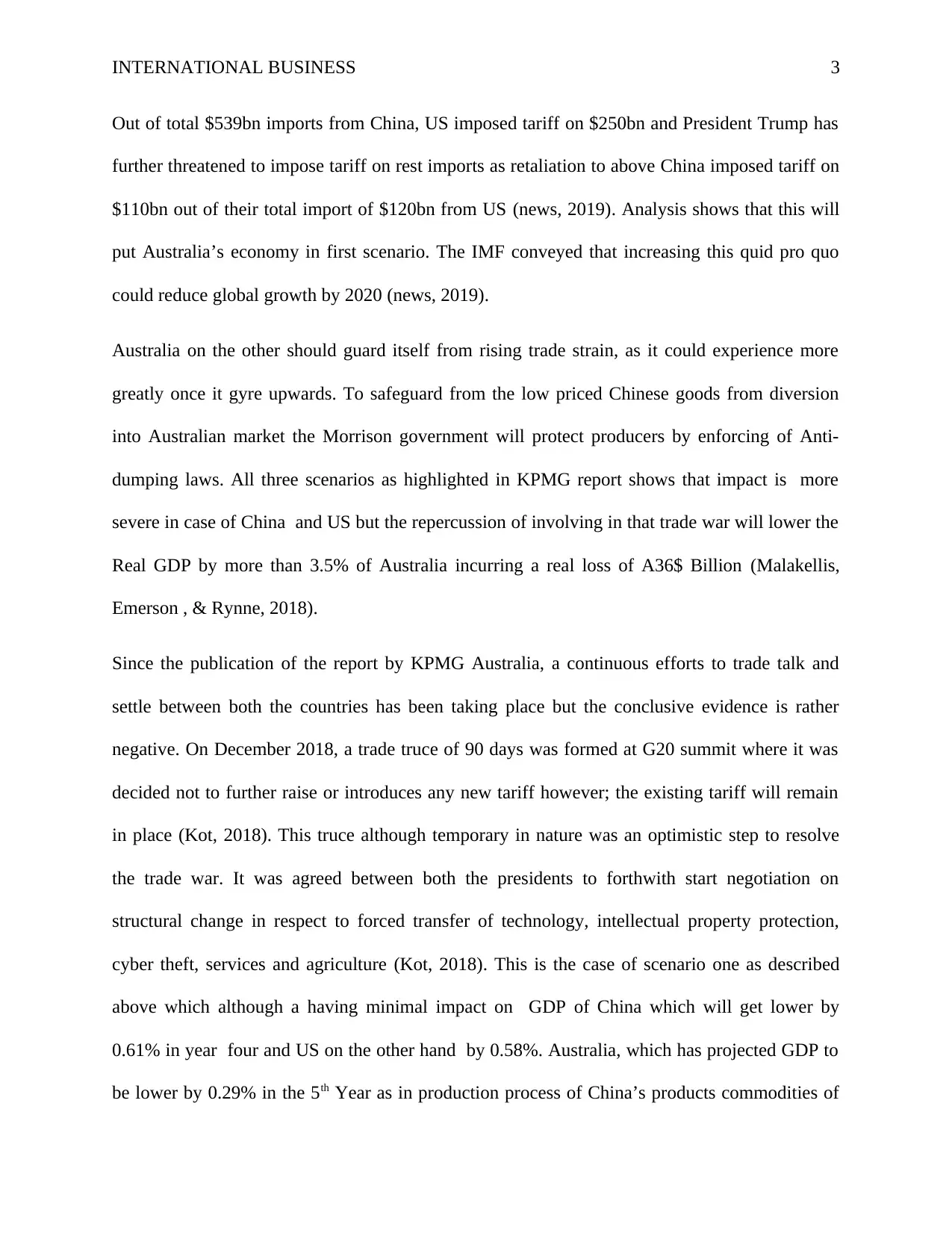
INTERNATIONAL BUSINESS 3
Out of total $539bn imports from China, US imposed tariff on $250bn and President Trump has
further threatened to impose tariff on rest imports as retaliation to above China imposed tariff on
$110bn out of their total import of $120bn from US (news, 2019). Analysis shows that this will
put Australia’s economy in first scenario. The IMF conveyed that increasing this quid pro quo
could reduce global growth by 2020 (news, 2019).
Australia on the other should guard itself from rising trade strain, as it could experience more
greatly once it gyre upwards. To safeguard from the low priced Chinese goods from diversion
into Australian market the Morrison government will protect producers by enforcing of Anti-
dumping laws. All three scenarios as highlighted in KPMG report shows that impact is more
severe in case of China and US but the repercussion of involving in that trade war will lower the
Real GDP by more than 3.5% of Australia incurring a real loss of A36$ Billion (Malakellis,
Emerson , & Rynne, 2018).
Since the publication of the report by KPMG Australia, a continuous efforts to trade talk and
settle between both the countries has been taking place but the conclusive evidence is rather
negative. On December 2018, a trade truce of 90 days was formed at G20 summit where it was
decided not to further raise or introduces any new tariff however; the existing tariff will remain
in place (Kot, 2018). This truce although temporary in nature was an optimistic step to resolve
the trade war. It was agreed between both the presidents to forthwith start negotiation on
structural change in respect to forced transfer of technology, intellectual property protection,
cyber theft, services and agriculture (Kot, 2018). This is the case of scenario one as described
above which although a having minimal impact on GDP of China which will get lower by
0.61% in year four and US on the other hand by 0.58%. Australia, which has projected GDP to
be lower by 0.29% in the 5th Year as in production process of China’s products commodities of
Out of total $539bn imports from China, US imposed tariff on $250bn and President Trump has
further threatened to impose tariff on rest imports as retaliation to above China imposed tariff on
$110bn out of their total import of $120bn from US (news, 2019). Analysis shows that this will
put Australia’s economy in first scenario. The IMF conveyed that increasing this quid pro quo
could reduce global growth by 2020 (news, 2019).
Australia on the other should guard itself from rising trade strain, as it could experience more
greatly once it gyre upwards. To safeguard from the low priced Chinese goods from diversion
into Australian market the Morrison government will protect producers by enforcing of Anti-
dumping laws. All three scenarios as highlighted in KPMG report shows that impact is more
severe in case of China and US but the repercussion of involving in that trade war will lower the
Real GDP by more than 3.5% of Australia incurring a real loss of A36$ Billion (Malakellis,
Emerson , & Rynne, 2018).
Since the publication of the report by KPMG Australia, a continuous efforts to trade talk and
settle between both the countries has been taking place but the conclusive evidence is rather
negative. On December 2018, a trade truce of 90 days was formed at G20 summit where it was
decided not to further raise or introduces any new tariff however; the existing tariff will remain
in place (Kot, 2018). This truce although temporary in nature was an optimistic step to resolve
the trade war. It was agreed between both the presidents to forthwith start negotiation on
structural change in respect to forced transfer of technology, intellectual property protection,
cyber theft, services and agriculture (Kot, 2018). This is the case of scenario one as described
above which although a having minimal impact on GDP of China which will get lower by
0.61% in year four and US on the other hand by 0.58%. Australia, which has projected GDP to
be lower by 0.29% in the 5th Year as in production process of China’s products commodities of
Paraphrase This Document
Need a fresh take? Get an instant paraphrase of this document with our AI Paraphraser
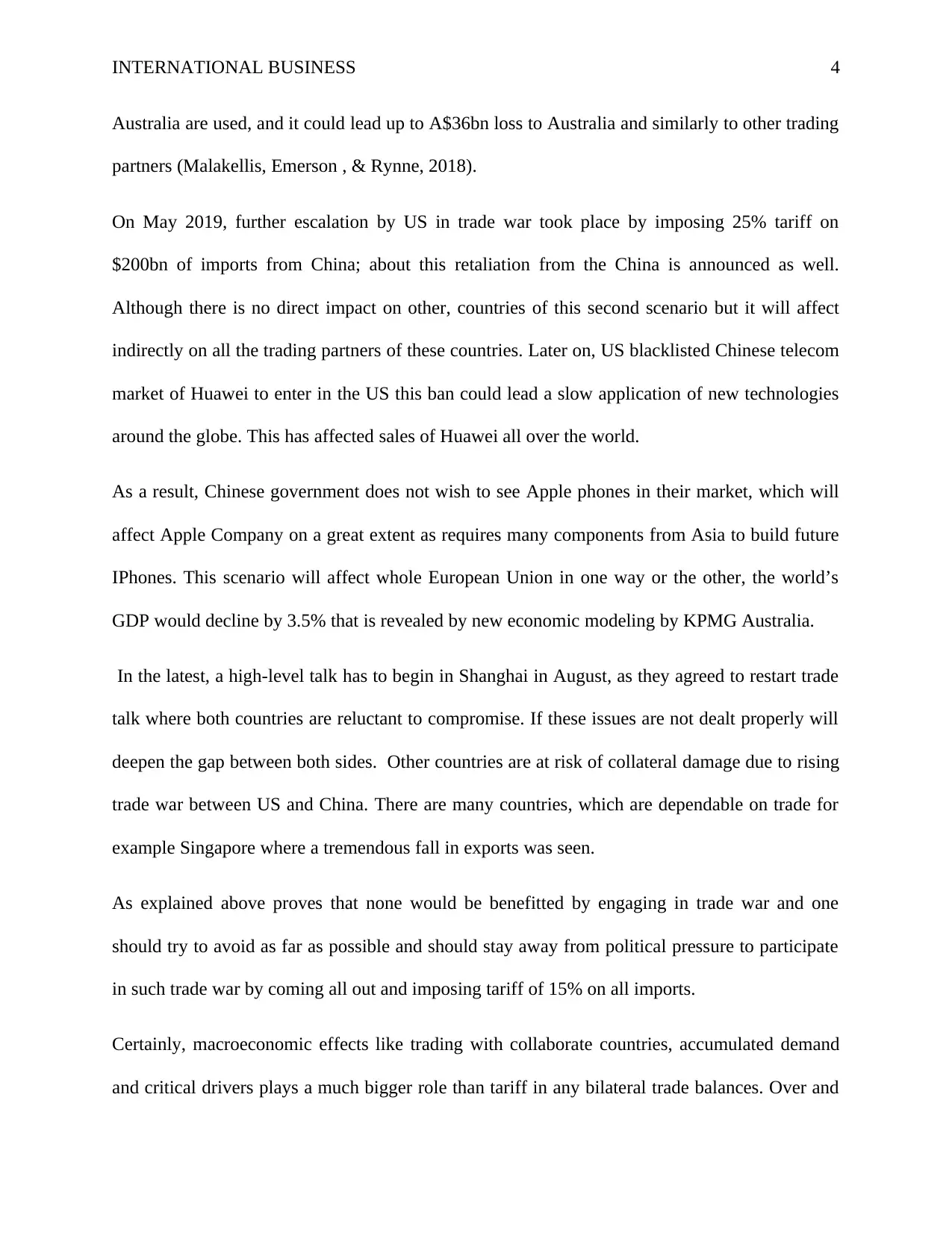
INTERNATIONAL BUSINESS 4
Australia are used, and it could lead up to A$36bn loss to Australia and similarly to other trading
partners (Malakellis, Emerson , & Rynne, 2018).
On May 2019, further escalation by US in trade war took place by imposing 25% tariff on
$200bn of imports from China; about this retaliation from the China is announced as well.
Although there is no direct impact on other, countries of this second scenario but it will affect
indirectly on all the trading partners of these countries. Later on, US blacklisted Chinese telecom
market of Huawei to enter in the US this ban could lead a slow application of new technologies
around the globe. This has affected sales of Huawei all over the world.
As a result, Chinese government does not wish to see Apple phones in their market, which will
affect Apple Company on a great extent as requires many components from Asia to build future
IPhones. This scenario will affect whole European Union in one way or the other, the world’s
GDP would decline by 3.5% that is revealed by new economic modeling by KPMG Australia.
In the latest, a high-level talk has to begin in Shanghai in August, as they agreed to restart trade
talk where both countries are reluctant to compromise. If these issues are not dealt properly will
deepen the gap between both sides. Other countries are at risk of collateral damage due to rising
trade war between US and China. There are many countries, which are dependable on trade for
example Singapore where a tremendous fall in exports was seen.
As explained above proves that none would be benefitted by engaging in trade war and one
should try to avoid as far as possible and should stay away from political pressure to participate
in such trade war by coming all out and imposing tariff of 15% on all imports.
Certainly, macroeconomic effects like trading with collaborate countries, accumulated demand
and critical drivers plays a much bigger role than tariff in any bilateral trade balances. Over and
Australia are used, and it could lead up to A$36bn loss to Australia and similarly to other trading
partners (Malakellis, Emerson , & Rynne, 2018).
On May 2019, further escalation by US in trade war took place by imposing 25% tariff on
$200bn of imports from China; about this retaliation from the China is announced as well.
Although there is no direct impact on other, countries of this second scenario but it will affect
indirectly on all the trading partners of these countries. Later on, US blacklisted Chinese telecom
market of Huawei to enter in the US this ban could lead a slow application of new technologies
around the globe. This has affected sales of Huawei all over the world.
As a result, Chinese government does not wish to see Apple phones in their market, which will
affect Apple Company on a great extent as requires many components from Asia to build future
IPhones. This scenario will affect whole European Union in one way or the other, the world’s
GDP would decline by 3.5% that is revealed by new economic modeling by KPMG Australia.
In the latest, a high-level talk has to begin in Shanghai in August, as they agreed to restart trade
talk where both countries are reluctant to compromise. If these issues are not dealt properly will
deepen the gap between both sides. Other countries are at risk of collateral damage due to rising
trade war between US and China. There are many countries, which are dependable on trade for
example Singapore where a tremendous fall in exports was seen.
As explained above proves that none would be benefitted by engaging in trade war and one
should try to avoid as far as possible and should stay away from political pressure to participate
in such trade war by coming all out and imposing tariff of 15% on all imports.
Certainly, macroeconomic effects like trading with collaborate countries, accumulated demand
and critical drivers plays a much bigger role than tariff in any bilateral trade balances. Over and
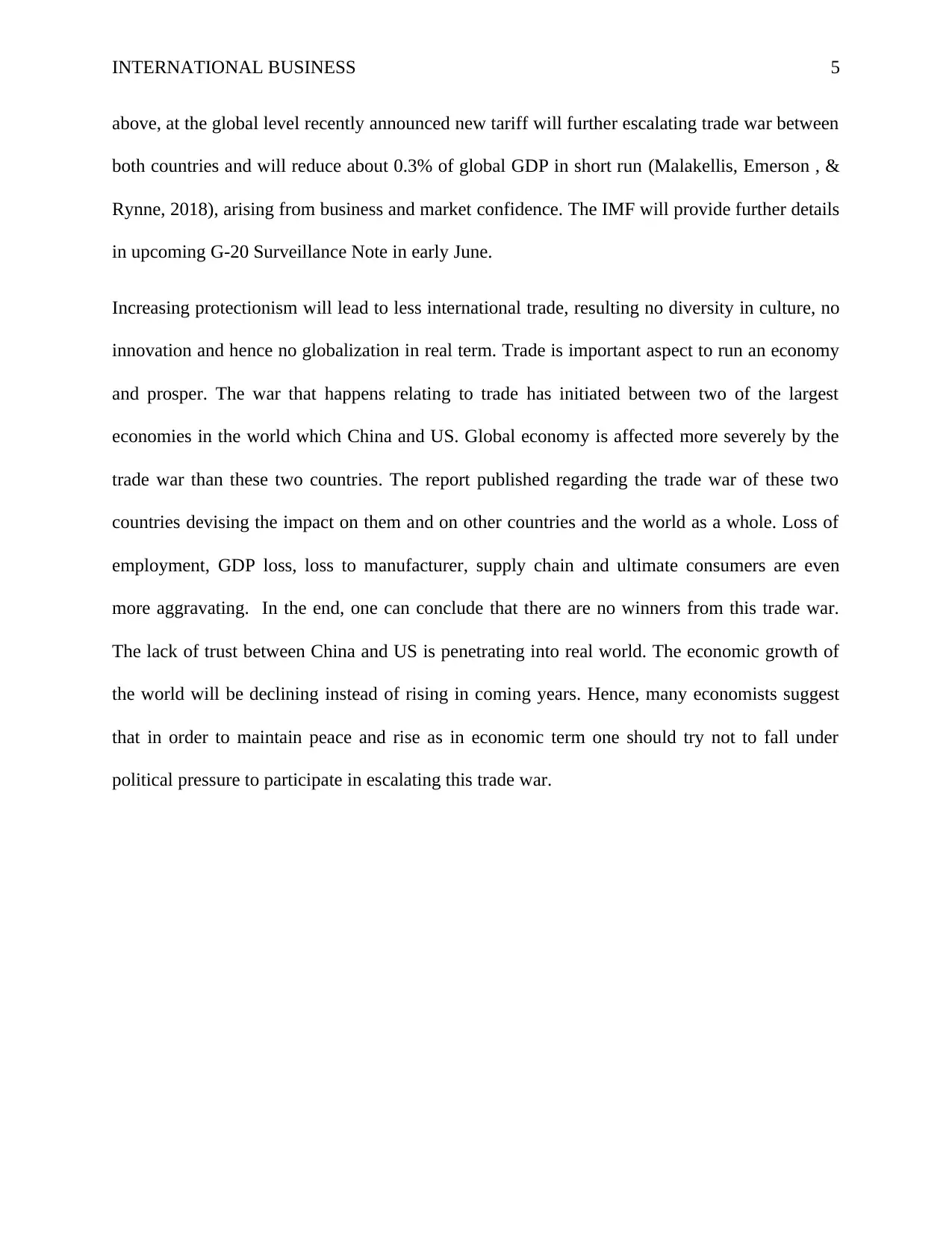
INTERNATIONAL BUSINESS 5
above, at the global level recently announced new tariff will further escalating trade war between
both countries and will reduce about 0.3% of global GDP in short run (Malakellis, Emerson , &
Rynne, 2018), arising from business and market confidence. The IMF will provide further details
in upcoming G-20 Surveillance Note in early June.
Increasing protectionism will lead to less international trade, resulting no diversity in culture, no
innovation and hence no globalization in real term. Trade is important aspect to run an economy
and prosper. The war that happens relating to trade has initiated between two of the largest
economies in the world which China and US. Global economy is affected more severely by the
trade war than these two countries. The report published regarding the trade war of these two
countries devising the impact on them and on other countries and the world as a whole. Loss of
employment, GDP loss, loss to manufacturer, supply chain and ultimate consumers are even
more aggravating. In the end, one can conclude that there are no winners from this trade war.
The lack of trust between China and US is penetrating into real world. The economic growth of
the world will be declining instead of rising in coming years. Hence, many economists suggest
that in order to maintain peace and rise as in economic term one should try not to fall under
political pressure to participate in escalating this trade war.
above, at the global level recently announced new tariff will further escalating trade war between
both countries and will reduce about 0.3% of global GDP in short run (Malakellis, Emerson , &
Rynne, 2018), arising from business and market confidence. The IMF will provide further details
in upcoming G-20 Surveillance Note in early June.
Increasing protectionism will lead to less international trade, resulting no diversity in culture, no
innovation and hence no globalization in real term. Trade is important aspect to run an economy
and prosper. The war that happens relating to trade has initiated between two of the largest
economies in the world which China and US. Global economy is affected more severely by the
trade war than these two countries. The report published regarding the trade war of these two
countries devising the impact on them and on other countries and the world as a whole. Loss of
employment, GDP loss, loss to manufacturer, supply chain and ultimate consumers are even
more aggravating. In the end, one can conclude that there are no winners from this trade war.
The lack of trust between China and US is penetrating into real world. The economic growth of
the world will be declining instead of rising in coming years. Hence, many economists suggest
that in order to maintain peace and rise as in economic term one should try not to fall under
political pressure to participate in escalating this trade war.
⊘ This is a preview!⊘
Do you want full access?
Subscribe today to unlock all pages.

Trusted by 1+ million students worldwide

INTERNATIONAL BUSINESS 6
Bibliography
Kot, A. C. (2018, December). US, China Reach Trade Truce, Announce 90-day Ceasefire at G20
Summit. Retrieved from China Breifing : https://www.china-briefing.com/news/us-china-
trade-truce-90-days-g20-summit/
Malakellis, M., Emerson , C., & Rynne, B. (2018, August). Trade Wars: There are no winners.
Retrieved from KMPG Australi:
https://assets.kpmg/content/dam/kpmg/au/pdf/2018/trade-wars-no-winners.pdf
news, B. (2019, June). A quick guide to the US-China trade war. Retrieved from bbc news:
https://www.bbc.com/news/business-45899310
Bibliography
Kot, A. C. (2018, December). US, China Reach Trade Truce, Announce 90-day Ceasefire at G20
Summit. Retrieved from China Breifing : https://www.china-briefing.com/news/us-china-
trade-truce-90-days-g20-summit/
Malakellis, M., Emerson , C., & Rynne, B. (2018, August). Trade Wars: There are no winners.
Retrieved from KMPG Australi:
https://assets.kpmg/content/dam/kpmg/au/pdf/2018/trade-wars-no-winners.pdf
news, B. (2019, June). A quick guide to the US-China trade war. Retrieved from bbc news:
https://www.bbc.com/news/business-45899310
1 out of 7
Related Documents
Your All-in-One AI-Powered Toolkit for Academic Success.
+13062052269
info@desklib.com
Available 24*7 on WhatsApp / Email
![[object Object]](/_next/static/media/star-bottom.7253800d.svg)
Unlock your academic potential
Copyright © 2020–2025 A2Z Services. All Rights Reserved. Developed and managed by ZUCOL.





